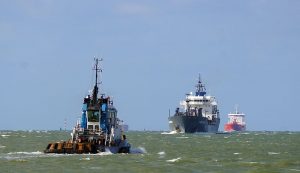Noise Pollution in the Ocean: A Growing Problem
By Rachael Ragen, SRC intern
Marine animals face many forms of pollution, but one of the less obvious forms that has potentially dangerous effects is noise pollution. Humans have always established civilizations near the water, but humans continue to explore further into the ocean and discover new resources. This shift brings a large amount of anthropogenic noise that can be “categorized as high-intensity and acute such as the noise produced by military sonar, pile driving and seismic explorations, or lower-level and chronic such as ship noise.” (Codarin 2009). Sound travels about four times faster in water than making the effects of sound pollution much more pronounced. It often goes unnoticed by humans since the sound of a motor may not be loud above water, but below it can be deafening. This can cause a great amount of stress for animals. Stress can be defined as “a threat to homeostasis” (Romano 2004). This stress can disrupt the normal behaviors of these animals including communication, diving, and hunting.

Cargo Ships [https://commons.wikimedia.org/wiki/ File:Cargo_Ships_at_Sekondi-Takoradi_Harbour_(Takoradi_Harbour).jpg]
Sound as a form of communication is especially important to the ecology of marine mammals. Many marine mammals live in groups and can be used as part of their social structure or group hunting strategies. It is also often used in locating prey as seen by the bottlenose dolphin and their use of echolocation.
The most extreme example is the response of beaked whales to sonar. There are mass strandings of beaked whales that coincide with military activities. It is believed that these sounds can disrupt normal diving behavior of these whales and cause them to rise much more rapidly. This can lead to gas bubbles in the tissues and the supersaturation of nitrogen in tissues, which could possibly lead to decompression sickness (Rommel 2006). This is likely the cause of death and mass strandings of these organisms. Ear injuries are also common in specimens from mass strandings. Many theories exist on this topic but the definitive cause of the strandings is still unclear.

Beaked Whale [https://commons.wikimedia.org/wiki/ File:The_True%27s_beaked_whale_
photographed_underwater.jpg]
Sensitivity to sound pollution has been shown across many species of marine mammals, including one study by Romano et. al. This study demonstrated the neural-immune response of a white whale and a bottlenose dolphin with the effect of intense sound from a seismic water gun, BEN water gun, and BEN tone. Blood was taken before and after an intense sound and the hormones were analyzed. While there were only two animals used in this study, the results of the blood analysis showed several changes in the immune response. As the study went on the animals began to become desensitized and did not show the same level of stress.
Stress responses have been observed across a wide range of animals besides marine mammals. Fish can communicate vocally, and it has been shown that anthropogenic sounds can greatly decrease the ability of fish to hear each other. Sensitivity was studied in damselfish, brown meagre, and the red-mouthed goby during this experiment. While the effect of the noise changes based on frequency, all species of fish were negatively affected (Codarin 2009).
Damselfish [https://en.wikipedia.org/wiki/Chromis _chromis#/media/File:Chromis_chromis_2.jpg]
Noise pollution is a problem for a large variety of marine animals. Further consideration for mitigation measures is required since the long term effects of sound pollution are relatively unknown and could be problematic for many animals. If stress is considered “a threat to homeostasis,” the increased stress levels could lower the ability of their immune system, reproductive success, and many other factors. This could be catastrophic for wild populations if management strategies are not established.
Works Cited
Codarin, A., L. Wysocki, F. Ladich, and M. Picciulina. 2009. Effects of ambient and boat noise on hearing and communication in three fish species living in a marine protected area (Miramare, Italy). 58(12):1880-1887.
Romano, T.A., M.J. Keogh, C. Kelly, P. Feng, L. Berk, C.E. Schlundt, D.A. Carder, and J.J. Finneran. 2004. Anthropogenic sound and marine mammal health: measures of the nervous and immune systems before and after intense sound exposure. Can. J. Fish. Aquat. Sci. 61:1124-1134.
Rommel, S.A., A. M. Costidis, A. Fernandez, P.D. Jepson, D.A. Pabsta, W.A. McLellana, D.S. Houser, T.W. Cranford, A.L. Van Heldenaa, D.M. Allen, and N.B.Barros. 2006. Elements of beaked whale anatomy and diving physiology and some hypothetical causes of sonar-related stranding. 7(3):189-209.
